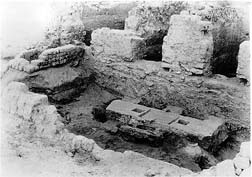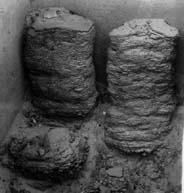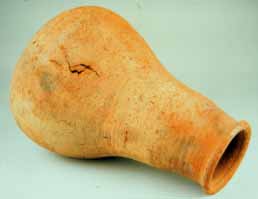A Taste of the Ancient World:
Farming at Karanis
Grapes
 |
Broken Iron Blade
KM 86.7.1
Greco-Roman
Karanis, Egypt |
This 'pruning hook' would have been used to cut grape clusters clinging
to the vine, or to remove brush and reeds. The wooden handle is made from
acacia (a native tree); the blade is fastened to it by iron rivets wrapped
in a palm fiber. The rarity of iron and wood in the Fayoum region suggests
that its owner valued it highly.
Olive Oil Production
 |
 |
Olive pressing room
Archive Photo 5-4219 |
Piles of olive residue in warehouse
Archive Photo 5-1576 |
As can be seen in the background of the archive photo illustrating the threshing process, olive trees thrive in the
area of Karanis. Although olive oil is very perishable, its production leaves
many traces. These two photos suggest that olive oil production was carried
out on a large scale at Karanis. The residue from olive pressing could be
used for animal feed or fuel. For many years, this olive residue was thought
to be bread, until scientific analysis determined its true nature.
 |
Olive processing residue
KM 4797
Roman
Karanis, Egypt |
Pigeons
 |
 |
Dovecote
Archive Photo 5-3489 |
Pigeon Pot
KM 20666
Roman
Karanis, Egypt |
Individual pigeon pots would have been placed within larger structures,
or dovecotes, to serve as nests. It has been estimated that as many as 4000
pigeons might have been kept at one time in Karanis. This pigeon pot was
essentially a house for domestic pigeons. Pigeons were bred primarily for
food, but their droppings were also extremely valuable as fertilizer. Pigeons
were also occasionally used in sacrificial rites.
Fishing
 |
Bronze Fishhook
KM 21409
1st c BC - 4th c AD
Karanis, Egypt |
Karanis was only about five miles from Lake Qarun. This proximity would
suggest that fishing was a common way to supplement
the usual cereal-based diet. Few fishhooks, however, were found at Karanis.
Perhaps others were removed when the site was abandoned, or their valuable
metal melted down and reused for other purposes.
Go on to Storage and Cooking.